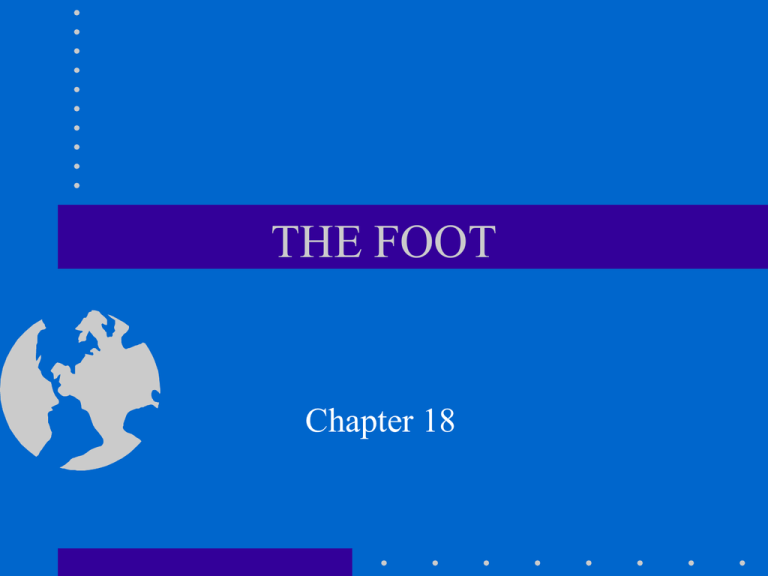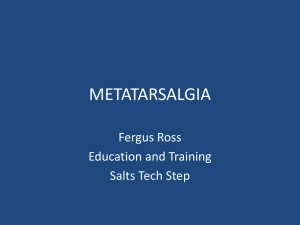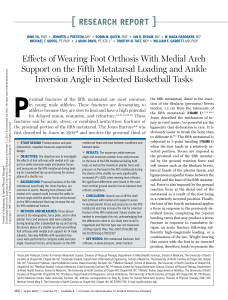THE FOOT
advertisement

THE FOOT Chapter 18 Introduction The traditional sports activities in which athletes compete at the high school, college and professional level all involve some elements of running, jumping and changing directions. The function of the foot is critical. One instant the foot must be a mobile adapter to absorb shock, and the next minute it must become a rigid lever to propel the body forward. Injury is common. Foot Anatomy • Bones – Phalanges, metatarsls, Tarsal Bones (Calcaneus, talus, navicular, cuboid, 3 cuneiform) • Articulations • Stabilizing Ligaments Foot Anatomy • Nerve Supply and Blood Supply – Nerve: tibial (back of leg/ plantar surface of foot) * common peroneal (front of leg & dorsal foot) – Blood: anterior and posterior tibial arteries • Arches – Longitudinal (medial and lateral) – Anterior metatarsal (runs across distal metatarsal heads; runs medially to laterally) – Transverse metatarsal (across tarsal bones; medially to laterally) • Plantar Fascia (medial calcaneus to proximal metatarsal heads) Muscles and Movements • Dorsiflexion: tibialis anterior, EDL, EHL, Peroneus Teritus • Plantar flexion: Gastrocnemius, soleus, planatris, peroneus longus and brevis, posterior tibialis, etc • Inversion, Adduction, Supination: tibialis posteriror, FDL, FHL, EHL, tibialis anteior • Eversion, Abduction, Pronation: peronus longus and brevis, peroneus tertius, EDL • Movement of phalanges: FDL, Quadratus plantar, lumbrical, interossei, EDL, EHL, EDB, etc Foot Biomechanics • Normal Gait Patterns • Pronation and Supination – Excessive Pronation (internal rotation of the leg); hypermobility at the joint – Excessive Supination (external rotation of the leg) • Other Structural Deformities Prevention of Foot Problems • Shoes & Socks – Construction • • • • Last: basic form shoe built on Upper: portion controling foot Midsole: affects stbaility Heel counter: control rearfoot motion – Selection • For pronated foot: less flexible; good rearfoot control; straightlasted (forefoot does not curve) • Proper Foot Care & Hygiene – Toenails trimmed, shaving calluses, keeping dry, wearing proper devices Foot Orthotics and Devices • Forefoot varus (excessive pronation) – Rigid type and medial wedge under head of 1dt metatarsal • Forefoot Valgus (excessive supination) – Semirigid and lateral wedge under 5th metatarsal • Rearfoot Varus – Semirigid and have wedge under medial calcaneus and small wedge under 1st metatarsal Assessing Foot Conditions • History • Observation • Palpation • Special Tests Recognition & Management Specific Injuries & Conditions • Injuries to the Tarsal Region – – – – – – – Talar Fracture Calcaneous Fracture / stress fracture Sever’s Disease Retrocalcaneal Bursitis Heel Contusion Cuboid Subluxation Tarsal Tunnel Syndrome Recognition & Management Specific Injuries & Conditions • Metatarsal Region – Flat foot (aka?) – High Arch (aka?) – Longitudinal Arch Strain (lateral ) – Plantar Fascitis (braces arch) – Jones Fracture (base of 5th) – Metatarsal stress fracture • Most common : 2nd – March Fx – Bunion (hallux valgus; 1st met.) – Sesamoditis – Metatarsalgia (2nd, 3rd met head) – Metatarsal arch strain – Morton’s Neuroma (b/t 3rd & 4th ) – Recognition & Management Specific Injuries & Conditions • Toes – Sprain – Turf Toe • Hyperextension injury to great toe – – – – – Fracture / dislocations (usually dorsal) Morton’s toe (short 1st met, WB on 2nd met) Hallux Rigidus (DJD, bony spurs dorsal aspect of 1st met) Hammer/Claw toes Overlapping toes Foot Rehabilitation • General body conditioning • Weight Bearing (pay attention to kinetic chain) • Joint Mobilization maintain/normalize joint motion) • Flexibility (especially as impact the phalanges) • Neuromuscular (strength & kinetic chain) • Foot Orthotics • Prevention from Reinjury Summary • The function of the foot is critical to athletic performance. • Evaluation and recognition of injuries and conditions can present a challenge to the athletic trainer. • Many chronic conditions of the lower extremity can be related to foot mechanics. • Management, rehabilitation, and prevention of foot conditions is essential.







